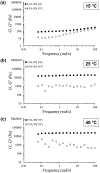Techniques to characterize dynamics in biomaterials microenvironments: XPCS and microrheology of alginate/PEO-PPO-PEO hydrogels
- PMID: 33367407
- PMCID: PMC7962546
- DOI: 10.1039/d0sm01628d
Techniques to characterize dynamics in biomaterials microenvironments: XPCS and microrheology of alginate/PEO-PPO-PEO hydrogels
Abstract
Many recent studies have highlighted the timescale for stress relaxation of biomaterials on the microscale as an important factor in regulating a number of cell-material interactions, including cell spreading, proliferation, and differentiation. Relevant timescales on the order of 0.1-100 s have been suggested by several studies. While such timescales are accessible through conventional mechanical rheology, several biomaterials have heterogeneous structures, and stress relaxation mechanisms of the bulk material may not correspond to that experienced in the cellular microenvironment. Here we employ X-ray photon correlation spectroscopy (XPCS) to explore the temperature-dependent dynamics, relaxation time, and microrheology of multicomponent hydrogels comprising of commercial poly(ethylene oxide)-poly(propylene oxide)-poly(ethylene oxide) (PEO-PPO-PEO) triblock copolymer F127 and alginate. Previous studies on this system have shown thermoreversible behavior in the bulk oscillatory shear rheology. At physiological temperatures, bulk rheology of these samples shows behavior characteristic of a soft solid, with G' > G'' and no crossover between G' and G'' over the measurable frequency range, indicating a relaxation time >125 s. By contrast, XPCS-based microrheology shows viscoelastic behavior at low frequencies, and XPCS-derived correlation functions show relaxation times ranging from 10-45 s on smaller length scales. Thus, we are able to use XPCS to effectively probe the viscoelasticity and relaxation behavior within the material microenvironments.
Conflict of interest statement
Conflicts of interest
There are no conflicts to declare.
Figures





References
MeSH terms
Substances
Grants and funding
LinkOut - more resources
Full Text Sources
Other Literature Sources

